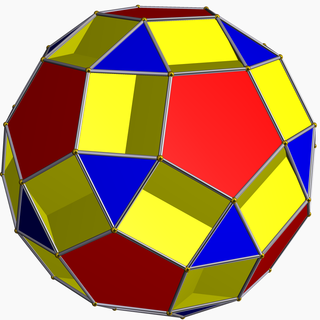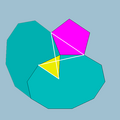| Small dodecicosidodecahedron | |
|---|---|
 | |
| Type | Uniform star polyhedron |
| Elements | F = 44, E = 120 V = 60 (χ = −16) |
| Faces by sides | 20{3}+12{5}+12{10} |
| Coxeter diagram | |
| Wythoff symbol | 3/2 5 | 5 3 5/4 | 5 |
| Symmetry group | Ih, [5,3], *532 |
| Index references | U 33, C 42, W 72 |
| Dual polyhedron | Small dodecacronic hexecontahedron |
| Vertex figure |  5.10.3/2.10 |
| Bowers acronym | Saddid |

In geometry, the small dodecicosidodecahedron (or small dodekicosidodecahedron) is a nonconvex uniform polyhedron, indexed as U33. It has 44 faces (20 triangles, 12 pentagons, and 12 decagons), 120 edges, and 60 vertices. [1] Its vertex figure is a crossed quadrilateral.













